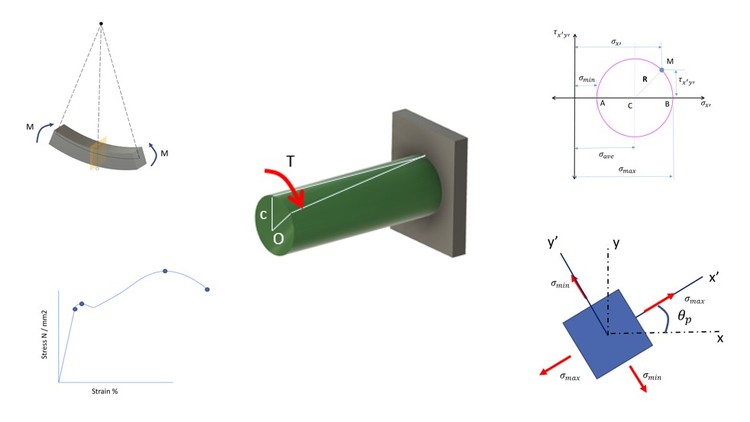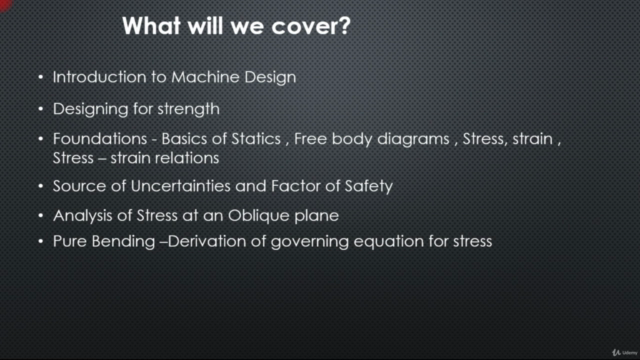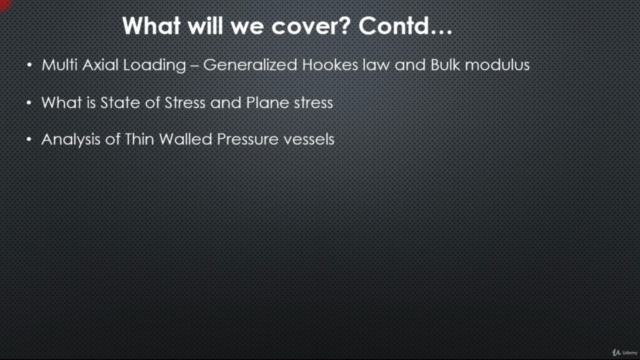Basic Concepts of Mechanics of Materials for Machine Design

Why take this course?
🚫 Basic Concepts of Mechanics of Materials for Machine Design: A Deep Dive into the Foundation of Structural & Machine Design⚙️
Are you ready to master the essentials of Mechanics of Materials, the bedrock upon which structural and machine design is built? If so, welcome to "Basic Concepts of Mechanics of Materials for Machine Design" – your gateway to understanding the fundamental concepts that every mechanical engineer must grasp.
🎓 Course Title: Basic Concepts of Mechanics of Materials for Machine Design
🔍 Course Headline: Learn the Foundation Concepts of Strength of Materials with Mathematical Derivations and Theory for Mechanical Engineering
Course Description: Mechanics of Materials is not just a subject; it's a foundational course for mechanical engineering that underpins the design of everything from simple structures to complex machinery. A profound understanding of its principles is critical for any form of mechanical design, whether you're dealing with stationary loads or intricate transmission systems subjected to dynamic forces. The concepts of Mechanics of Materials serve as the cornerstone for all types of mechanical design.
In this course, we will delve into the following key concepts:
-
Introduction to Machine Design - Discover what machine design encompasses, its nature, and the engineering design process that leads to innovation and practical solutions.
-
Importance of Analysis of Strength - Understand the distinction between strength and stress, and why it's crucial in the realm of mechanical design.
-
Engineering Stats - Master the method of statics, learn to draw free body diagrams, comprehend force equilibrium, and become familiar with different types of joints.
-
Types of Loading - Explore normal and shear loads, and their implications in design.
-
Bearing Stress - Learn what bearing stress is and how it's calculated.
-
Stress and Strain - Gain insights into the relations between stress and strain, including tensile tests, yield strength, and the importance of understanding these concepts through practical examples.
-
Hookes Law - Understand this fundamental principle that relates stress to strain.
-
Shear Stress and Strain Relations - Delve into shear stress in shafts under torque, particularly in torsion, and learn the implications for design.
-
Poissons' Ratio - Explore this key concept that describes the relationship between normal and tangential stresses.
-
Axially Loaded Member Analysis - Learn about stress concentration and its importance.
-
Stress in Oblique Plane for Axially Loaded Members - Understand the complexities of stress distribution at an angle to the axis.
-
Pure Bending - Derive the governing equations and understand their significance.
-
Area Moment of Inertia - Learn about its importance in beam analysis.
-
Analysis of Beams - Discover how to derive shear force and bending moment diagrams, essential tools for understanding beams under load.
-
Two Plane Bending in Shafts - Explore the implications of bending along two planes.
-
Stress Concentration in Bending - Learn how to identify and mitigate stress concentration issues.
-
Shaft Analysis in Torsion - Understand the derivation of the governing equations for torsion in solid and hollow shafts, and learn about stress concentration in these scenarios.
-
Multi-Axial Loading - Study the effects of more than one type of loading simultaneously.
-
Dilatation and Bulk Modulus - Learn how volume changes are related to stress.
-
State of Stress and Stress Transformations - Master the analysis of complex states of stress.
-
Analysis of Thin-Walled Pressure Vessels - Explore the unique challenges in designing vessels with thin walls.
-
Principal Stress and Mohr's Circle - Understand these advanced concepts for analyzing biaxial states of stress.
-
Maximum Shear Comparison - Learn to compare maximum shear stress with the principal stress.
The course is designed to cover the theoretical fundamentals necessary to design standard elements in structures and machines, ensuring that students are not just applying formulae but also understand the underlying mathematical principles that give these formulas meaning.
Our Aim: To build a robust and well-rooted understanding of the concepts, providing you with the skills to apply your knowledge effectively in real-world design scenarios. By the end of this course, you'll have a comprehensive grasp of Mechanics of Materials – not just as a subject to pass, but as a powerful tool in your engineering arsenal. 🛠️
Enroll now and embark on a journey to master the basics of Mechanics of Materials with confidence and precision! 🚀
Course Gallery




Loading charts...